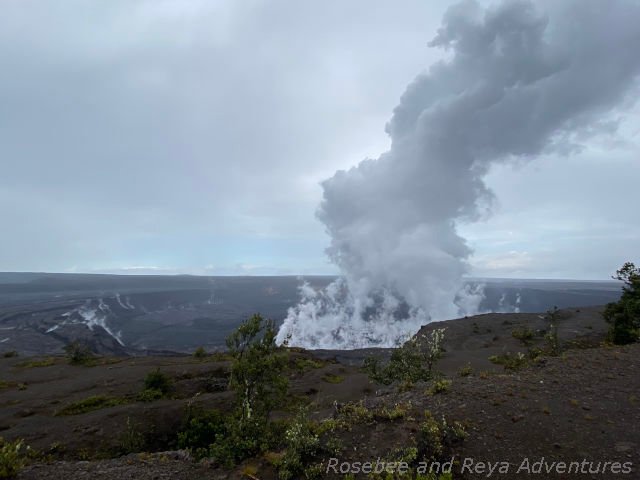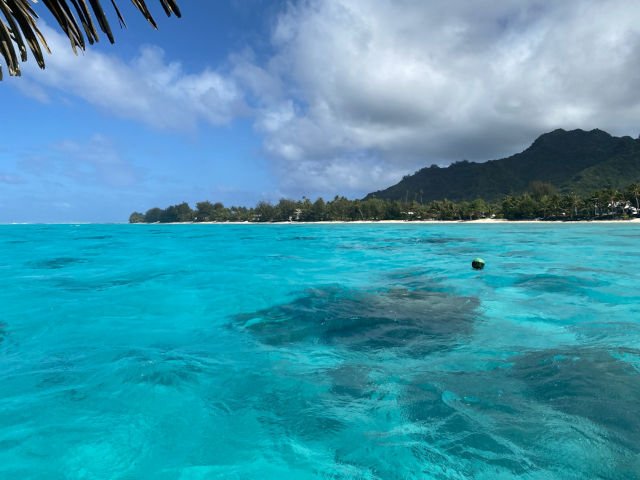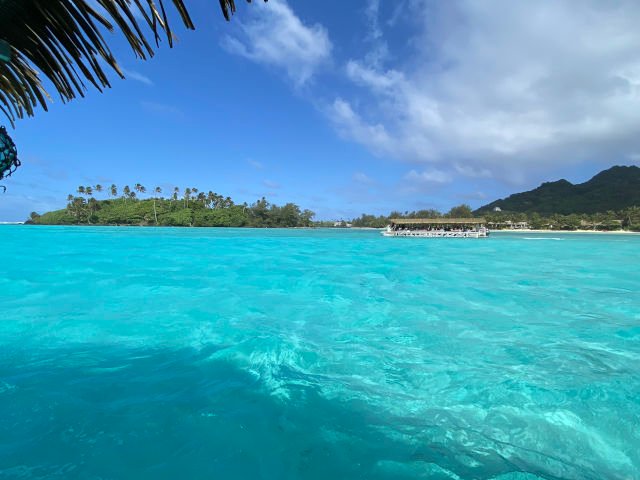Nestled on the eastern coast of Hawaii’s Big Island is Hilo, Hawaii. A hidden gem that promises a unique and authentic Hawaiian experience. There are many amazing things to do in Hilo. The town is surrounded by dense rainforests, dramatic waterfalls, and botanical gardens bursting with exotic flora. Rainbow Falls, located in the heart of Hilo, is a testament to the town’s natural beauty. Other nearby attractions include Akaka Falls State Park, with hiking trails that lead to its awe-inspiring cascades.
What makes Hilo truly special is its lush and tropical landscapes, rich cultural heritage, inviting and tranquil atmosphere, and amazing locals who embrace visitors like old friends. Hilo has a distinct charm that sets it apart as a must-visit destination. There are many places to visit in and around Hilo; here are some of the best things to do when visiting Hilo on the big island of Hawaii.
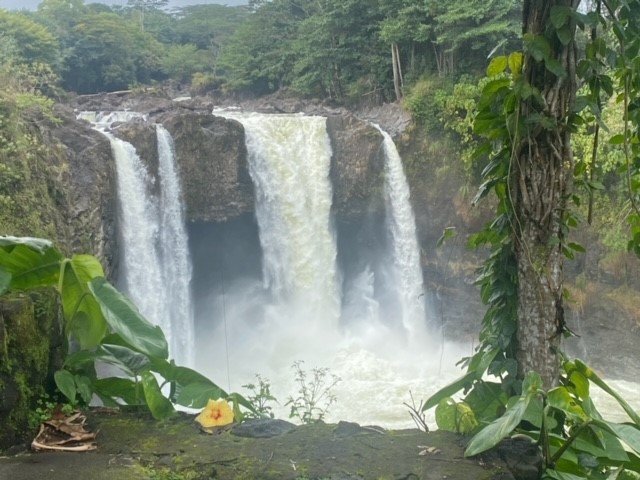
How to get to Hilo
Hilo is located in the eastern part of Hawaii’s Big Island. You can fly directly into Hilo via Hilo International Airport or drive to Hilo if you are staying in another part of Hawaii Island. If you are arriving at Hilo International Airport, the car rental agencies are located across the street from the terminal. Uber and Lyft are both available as a means of transportation on Hawaii’s Big Island, but the more remote the area, the more difficult it can be to get a ride when using a rideshare program. Ideally, having your own rental car will give you the freedom to come and go without the worry of not having a ride back to your hotel. There are many things to do in Hilo and the surrounding area which should not be missed. Having a rental car makes getting around town much easier.
Hilo Farmers Market
The Hilo Farmers Market is a great place to spend some time exploring and purchasing items that are for sale from the local community and local farms. The Farmers Market is a haven for fresh produce, tropical fruits, and handmade crafts, giving you a taste of fresh island flavors and handmade local crafts.
The Hilo Farmers Market is open daily from 7:00 a.m. until 3:00 p.m. and has different sections for food, fresh produce and fruit, and arts, crafts, and retail items. The big market days are on Wednesday and Saturday when you will find a larger selection of vendors and items for sale. There are outdoor picnic tables available near the lunch wagon and music area where you can have a nice lunch while enjoying the entertainment. To make your visit to the farmers market even easier, there is free parking is available for market attendees.
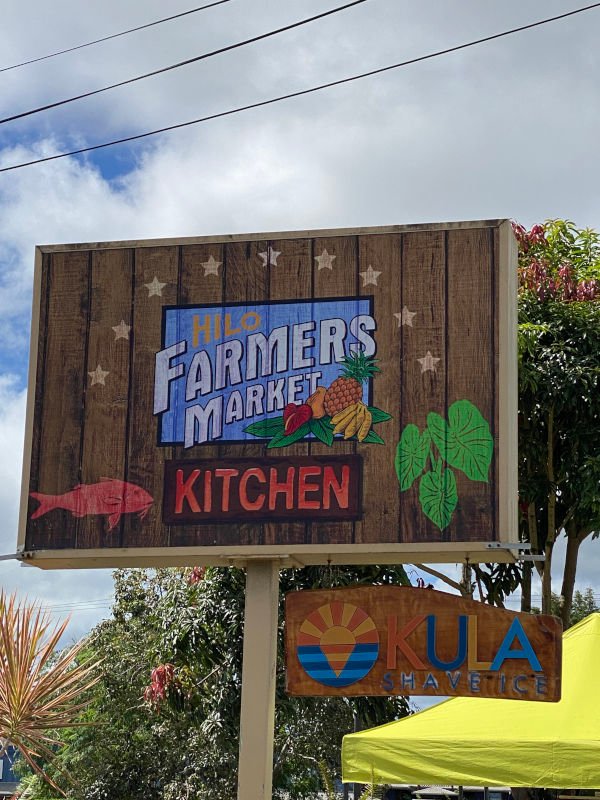

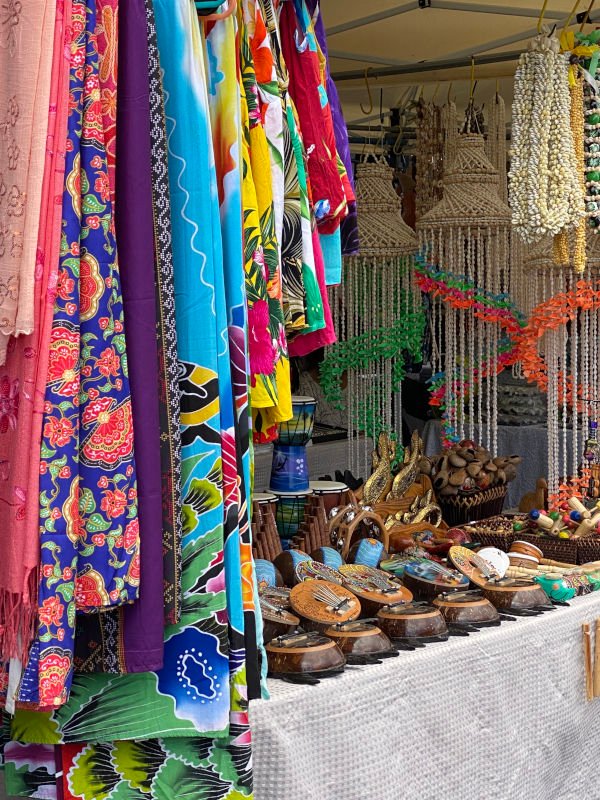
Visit the Pacific Tsunami Museum in Hilo
The Pacific Tsunami Museum was founded to commemorate two tsunamis that impacted the town of Hilo. The Pacific Tsunami of 1946 and the Chilean Tsunami in 1960 caused devastation in Hilo. The museum works to bring awareness and preparation for tsunamis. The Museum honors the memory of those that have been affected by tsunamis including the 2004 Indian Ocean tsunami. The museum is a great place to learn about what causes a tsunami and how people can prepare.
The Pacific Tsunami Museum is located at 130 Kamehameha Boulevard in Hilo. The museum is open daily from 10:00 am to 4:00 pm. General admission is $15.00 per person, $10.00 for military and seniors and $5.00 for kaima’aina and children between the ages of 6 to 17.
Liliuokalani Gardens – Edo-style Japanese Gardens in Hilo
Liliuokalani Gardens is a public park located in Hilo. The gardens were dedicated in 1917 as a tribute to Hawaii’s Japanese immigrants. The park is beautifully maintained and offers a relaxing way to spend a part of your day. The park has several fish ponds, picturesque bridges, pagodas, and an authentic Japanese tea house. Liliuokalani Gardens is a great place to bring a picnic lunch and have a leisurely and relaxing afternoon lunch. It is a great place to visit and should not be missed when visiting Hilo.
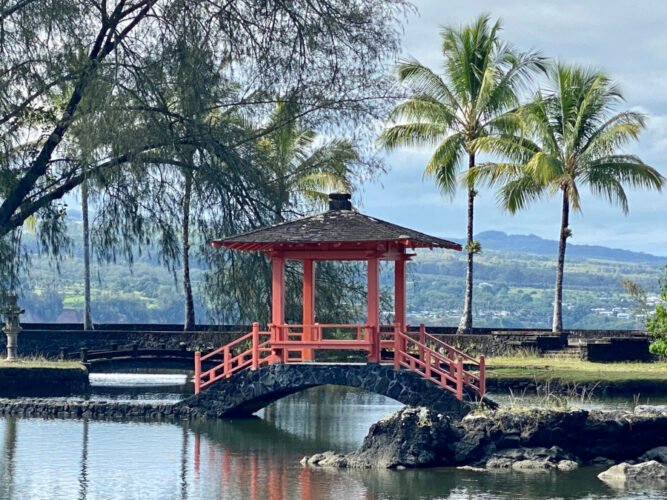
Moku Ola – Coconut Island
Across the way from Liliuokalani Gardens, off of Kelipio Place, is a footbridge that leads to a small island named Moku Ola, also known as Coconut Island. Moku Ola has several picnic areas, a large grassy field, restrooms, and small sandy beaches where you can enjoy a refreshing dip in Hilo Bay. At Moku Ola, you will have wonderful views of Hilo Bay, the downtown Hilo area, and the Mauna Kea volcano.
The beach areas resemble small bays and have stairs built out of lava rock that leads into the water to make entry easier. Moku Ola is well known to locals; you will often see families picnicking and enjoying a swim in Hilo Bay. If you choose not to walk the footbridge to the island, you can still enjoy the bay, as there is ocean access from the parking lot adjacent to the footbridge. Here you will find steps leading into the water, making entry into the bay very easy. Moku Ola is a relaxing and very tranquil island and is a great place to visit and spend an afternoon.

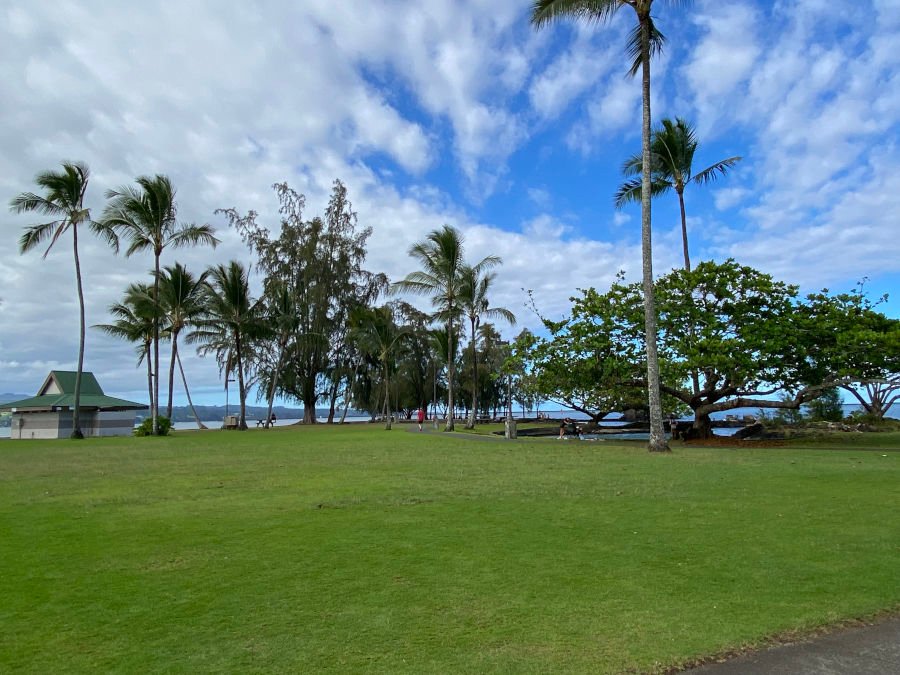
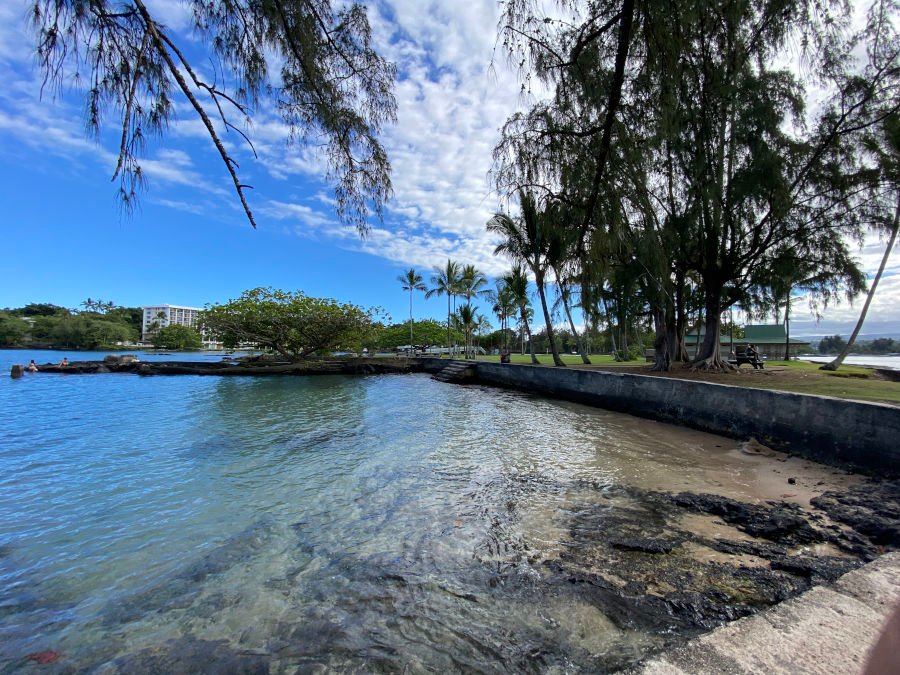
Visit Wailuku River State Park
Right in the heart of Hilo, Wailuku River State Park is a testament to the raw and awe-inspiring beauty that characterizes the Hawaiian landscape. Wailuku River State Park is home to two breathtaking waterfalls on the island – Rainbow Falls and Pe’e Pe’e Falls.
The Wailuku River State Park is located via Waiānuenue Avenue in downtown Hilo. There is ample parking available at the state park, and there is no charge to park. The Wailulu River State Park has two tourist areas: Rainbow Falls and the Pe’epe’e Falls, which feed the Boiling Pots.
Rainbow Falls
Rainbow Falls is located on Rainbow Drive off of Waiānuenue Avenue in Hilo. The waterfall is located within the Wailuku River State Park and is free to enter. Ample parking is available at the state park.
Rainbow Falls cascades over a cave that was created by lava years ago. According to Hawaiian legend, the lava cave beneath the waterfall was the home of the Hawaiian goddess Hina, goddess of the moon and mother to the demigod Maui.
Rainbow Falls is a beautiful sight to behold. The waterfall’s mist creates a rainbow that is visible as the water hits the pond below. As the sun filters through the mist, the colors of the rainbow dance across the water. The ideal time to see the rainbow effect is in the morning, preferably a sunny morning; however, the rainbow effect was visible during a recent afternoon visit. The level of rainfall affects the waterfall. During heavier rainfall, there is more water cascading down the falls. If there is a dry spell, you could end up seeing a trickle instead of a cascading waterfall. Regardless, Rainbow Falls is truly a beautiful waterfall to visit. The 80-foot waterfall plunges into a jade-colored pool surrounded by lush foliage. The waterfall, surrounding foliage, and the rainbow effect join together to create a tranquil oasis that feels almost mystical.
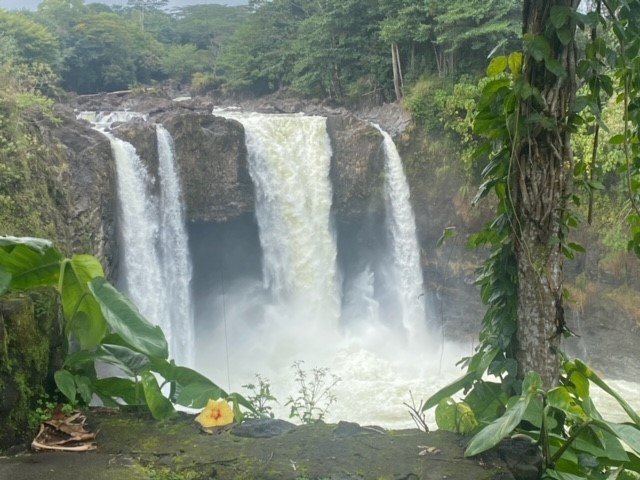
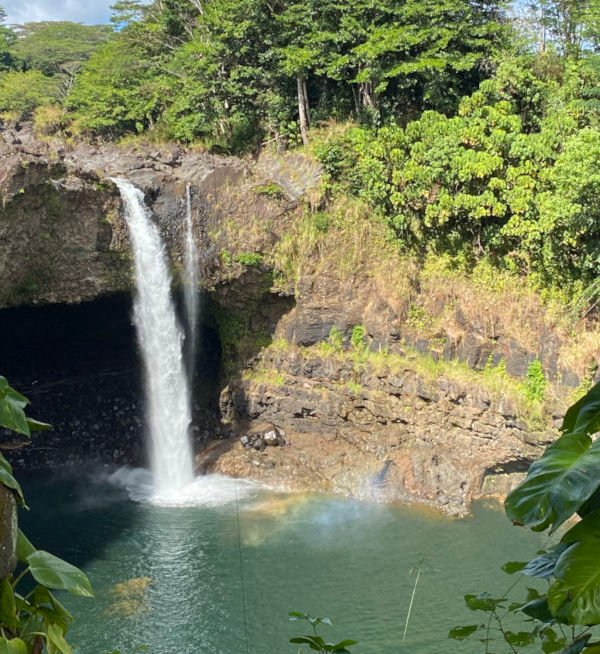
Pe’e Pe’e Falls and The Boiling Pots
Pe’epe’e Falls and The Boiling Pots are located just upstream from Rainbow Falls off of Waiānuenue Avenue at the end of Peʻepeʻe Falls Drive. Like Rainbow Falls, Pe’epe’e Falls, and The Boiling Pots are located within Wailuku River State Park and are free to enter. There is also a picnic area and bathrooms available if necessary.
The Pe’epe’e Falls area of Wailuku River State Park offers a more secluded encounter with nature. Its cascading waters tumble down a lava rock wall into a clear pool. While you can no longer get close to the falls, you can get a great view from the lookout. The Boiling Pots are a succession of big pools connected by an underground flow of water and cascades whose waters roll and bubble as though they are boiling. The boiling effect is affected by rainfall, and thus, it is more pronounced after rainfall and less visible during the dry season.
Both Rainbow Falls and Pe’epe’e Falls areas are located within a short distance from each other, allowing you to experience two distinct waterfalls in a single journey. Wailuku River State Park is more than just a scenic spot – it’s a place to connect with nature and experience the profound sense of peace that only such a beautiful landscape can provide.
The Pana’ewa Rainforest Zoo
The Pana’ewa Rainforest Zoo is a unique destination where you can see a variety of exotic animals in a lush tropical setting. The zoo is located in the Pana’ewa Forest and houses about 200 animals. The Pana’ewa Forest receives about 125 inches of rainfall annually, which contributes to the unique tropical setting of the zoo. The Rainforest Zoo is a great family-friendly activity that provides insight into Hawaii’s diverse ecosystems.
The Pana’ewa Rainforest Zoo is located at 800 Stainback Highway in Hilo and is open most days between 8:00 AM and 4:00 PM. Entering the zoo is free, making this a perfect low-cost family outing.
Hawaii Volcanoes National Park – One of the Best things to do when Visiting Hilo
Hawaii Island is home to Hawaii Volcanoes National Park. At Hawaii Volcanoes National Park, you can visit the Kilauea volcano, Hawaii Island’s most active volcano, and witness the raw power of nature. At Hawaii Volcanoes National Park, you can also see the steam vents, explore the Thurston Lava Tube, hike various trails on lava fields, and visit the Petroglyphs and various craters along the Chain of Craters Road. You can drive the Chain of Craters Road to where it ends near the ocean and visit the Holei Sea Arch. During the evening, you can even catch a glimpse of the glowing molten lava of Kilauea if there is volcanic activity during your visit.
Hawaii Volcanoes National Park is located off Highway 11, approximately 30 miles from Hilo. Because of its close proximity to Hilo, visiting the National Park is one of the best things to do when visiting Hilo. To learn more about the incredible adventures you can experience at Hawaii Volcanoes National Park, read our blog on the 8 Best Things to do at Hawaii Volcanoes National Park.
Explore Akaka Falls and Kahuna Falls
A trip to Akaka Falls State Park offers visitors the opportunity to visit two picturesque waterfalls, Akaka Falls and Kahuna Falls. Akaka Falls is located off Highway 220, also known as Akaka Falls Road, and is approximately 25 minutes from Hilo.
The Akaka Falls State Park offers a scenic hike through lush rainforest to reach the breathtaking 442-foot Akaka Falls. The 0.4-mile hike is a moderate hike on a paved road located just past the parking lot. There are stairs located in several parts of the trail; unfortunately, the stairs make this park unsuitable for those in a wheelchair. At the start of the trail, there is an option to go either left or right. If you want to go directly to Akaka Falls and take a shorter trail, go left at the start of the trail. If you go right, you will follow the complete trail and see both waterfalls.
When taking the longer trail, the first waterfall you will visit is Kahuna Falls. Kahuna Falls is 100 feet high, and while there is a lot of vegetation surrounding the area, Kahuna Falls is still beautiful to see. The trail continues to Akaka Falls, and at 442 feet high, it is a magnificent waterfall to see. The cascading waterfall surrounded by vibrant greenery creates a picture-perfect setting for nature lovers and photographers.
Parking at Akaka Falls State Park
There is ample parking available. However, there are times when the parking lot can get full. Luckily there are attendants at the park that assist visitors in the parking lot. If you do arrive during a time when the parking lot is full, you will more than likely wait no more than five or ten minutes for a space to open up. The parking attendants are there to control traffic during busy times and are very helpful. After you park, an attendant will assist you near the park entrance.
How Much Does it Cost to Visit the Park?
The entrance fee to the park includes both a parking fee and an entrance fee per person. Currently, the parking fee is $10.00, and the park entrance fee is $5.00 per person. You will pay your entry fee by using the park pay machines. If you have any questions regarding how to use the payment machine, the attendant will assist you and answer any questions you might have.
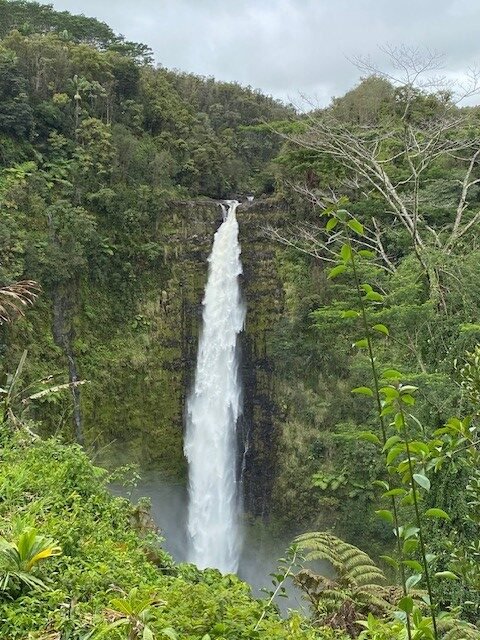
Drive the Scenic Route on Old Mamalahoa Road
Old Mamalahoa Road is a beautiful scenic winding coastline route about 5 miles north of Hilo. We drove Old Mamalahoa Road on our way to the Hawaii Tropical Bioreserve and Garden. Along the way, we stopped at a beautiful scenic lookout and walked a trail overlooking Onomea Bay.
Old Mamalahoa Road was once the main road that connected Hilo, Waimea, and the sugar plantations along the Hamakua coast. Nowadays, most people travel along Hawaii Belt Road, and unless their destination includes the tropical reserve or the Onomea trail, they can easily miss this beautiful scenic road.
Subscribe to our Travel Newsletter!
Receive our free Packing Guide with Bonus Cruise Essentials Checklist and Waikiki Travel Guide with Map when you subscribe.
Explore the Hawaii Tropical Bioreserve and Garden
The Hawaii Tropical Bioreserve and Garden stands as a verdant testament to Hawaii Island’s diverse and lush flora. The Bioreserve spans 100 acres, of which 20 acres make up the botanical gardens and visitor’s center. The botanical garden offers visitors a unique opportunity to learn about and view a diverse and rich tapestry of tropical plant species from around the world. The garden’s meticulously curated collections showcase an array of vibrant flowers, exotic trees, and rare plants, making the botanical garden an amazingly colorful and beautiful place to visit on Hawaii Island.
What sets the Hawaii Tropical Bioreserve and Garden apart is not just its remarkable variety of plant life but also its commitment to education and conservation. Beyond its role as a scenic attraction, the garden serves as an educational hub where visitors can learn about the importance of preserving the importance of the earth’s ecosystems. Moreover, the garden plays an active part in conservation efforts, aiming to protect endangered plant species through propagation and habitat restoration initiatives. The botanical garden not only offers a serene and visually stunning experience but also fosters a deeper understanding of the delicate balance that sustains our natural world.
Important things to know about the Trail at the Botanical Garden
The botanical garden is located in the Onomea Valley. The garden trails were built around and to mimic the terrain of the Onomea Valley. Because of this, it is important to note that certain parts of the trail are steep. The boardwalk entry into the botanical garden is also very steep, and thus, mobility assistance devices such as wheelchairs, walkers, scooters, and crutches are not allowed. Walking sticks and canes for walking assistance are allowed.
The trail at the botanical garden is approximately 1.25 miles long. Since there is so much to see at the botanical garden, it can take about 2 hours or so to walk the trail. You should wear comfortable shoes, and it is a good idea to bring water, snacks, and insect repellent.
How to Get to the Botanical Garden
The Hawaii Tropical Bioreserve and Garden is located at 27-717 Old Mamalahoa Hwy in Papaikou, about 15 minutes north of Hilo. To get to the Hawaii Tropical Bioreserve and Garden, take Highway 19 (Hawaii Belt Road) to Old Mamalahoa Road, which is also known as the scenic route. You will arrive at the visitor’s center in about 1.50 miles.
Hike the Onomea Bay Trail
What you should know about the Onomea Trail
There are two start areas for the Onomea Bay Trail. You can start the trail either at the Donkey Trailhead or the Onomea Bay Trailhead. When driving northbound on the scenic route on Old Mamalahoa Road, you will come to the Onomea Trailhead. You will come to the Donkey Trailhead if you drive southbound on Old Mamalahoa Road. There are three connected trails that you can hike in this area. The total length of all the trails is 0.6 miles or 1.2 miles round trip. The trails are not very difficult. Part of the trail is paved, but a large portion of the trail is not paved, including the Donkey Trail. It definitely helps to wear proper shoes and have bug spray with you as you hike the Onomea Bay Trail. And as always, taking water with you on your trek is a must.
Parking for the Onomea Trail is roadside, and there is no charge to hike the Onomea Bay Trail. When you reach the small bridge, you will find that the trail cuts through the botanical garden. However, if you stay on the paved path on the bridge, you will remain on the Onomea Trail. There is usually a guard to help direct people to stay either on the path through the botanical garden for garden customers or on the path for the Onomea trail for hikers.
Hiking the Onomea Bay Trail
If you start the trail at the Onomea Trailhead, about midway through your hike, you will come to the first break, where you can change your course of direction and go down the Alakahi Trail. The Alakahi Trail is very short and ends with a picturesque view of the area where the Alakahi Stream meets the ocean.
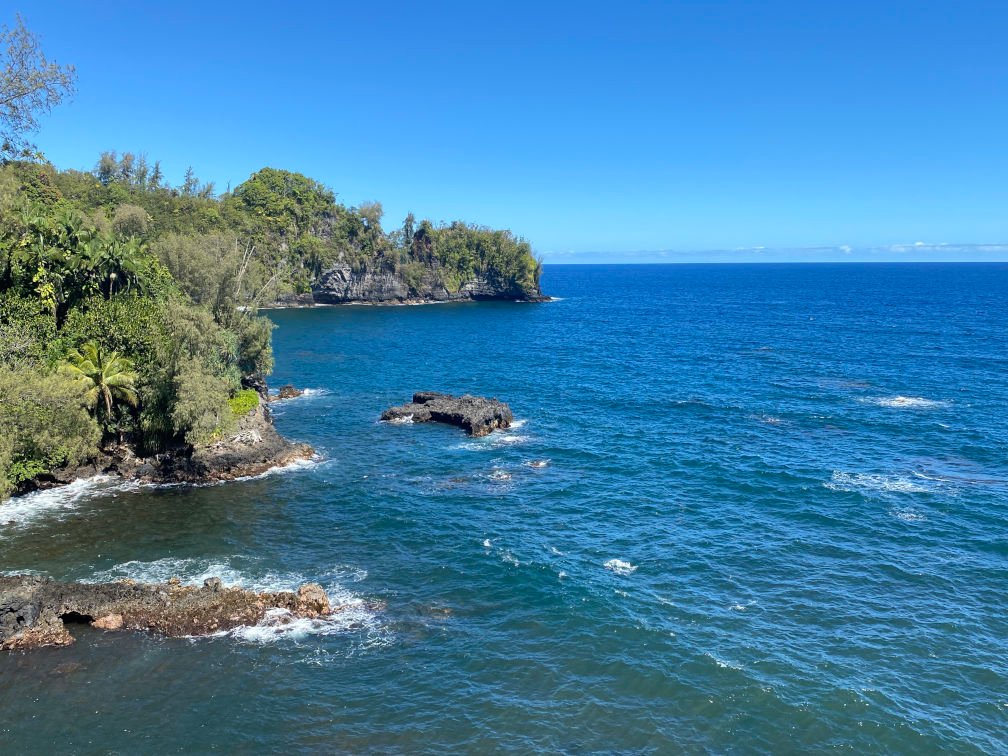
To continue on to Onomea Bay, go back up the Alakahi Trail to return to the Onomea Bay Trail. As you walk the trail, you will come to the Botanical Garden, where you will continue to go straight on the path to Onomea Bay. This trail area becomes rocky and can be slippery if there is rainfall. However, the reward at the end of this part of the trail is the view of the bay, which is absolutely amazing.
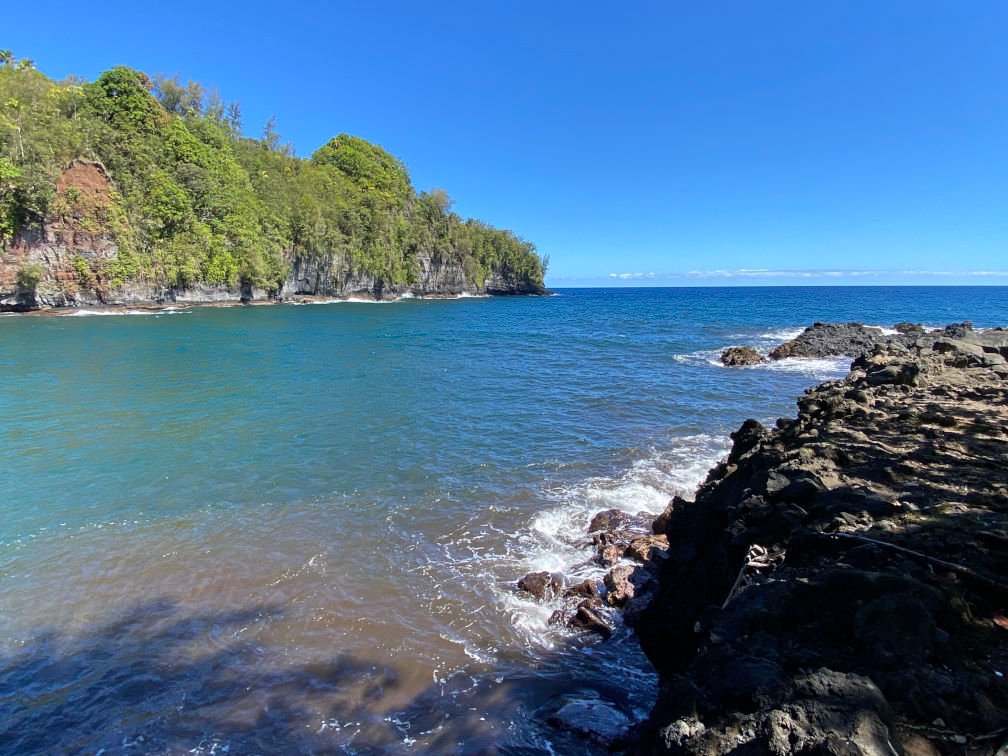
The third part of the trail is the Donkey Trailhead. If you continue upwards on the Onomea Trail, you will be walking the Donkey Trail. This part of the trail will take you through a steep hill with lots of vegetation. Proper shoes are very important on this part of the trail because the trail is steep and can be slippery. The Donkey trail ends at a different section of Old Mamalahoa Road. If you hike the Donkey Trail, you can walk back to your car using Old Mamalahoa Road or return to your car by following the trail back.
The Onomea Bay trail is a trek that should not be missed. The views are amazing and picture-worthy. The trail is tranquil and peaceful, and it is a great place to meditate, relax, and take in the beauty of Hawaii Island.
Spend a Day at one of the beautiful beaches in Hilo
There are many beautiful beaches that you can visit in Hilo. Many of the beaches have ample parking, picnic tables, grass areas, BBQ pits, and bathroom facilities. Each beach is different; some have a sandy beach, and others are more bay-like. Whichever beach you decide to visit, you will not be disappointed, as Hilo has some of the most beautiful and swimmable beaches.
Moku Ola – Coconut Island
As mentioned above, Moku Ola, also known as Coconut Island, is about a 5-minute drive from Downtown Hilo and just steps away from the Lili’uokalani Gardens. If you decide to spend a day or afternoon on Moku Ola, you will have a beautiful view of Hilo Bay, the Downtown Hilo area, and Mauna Kea while enjoying a relaxing time on the island.
The beaches on Moku Ola resemble small calm bays, making them a great spot for children to swim and play. To get into the water at Moku Ola, steps are built into the lava rock that leads into the water from the walls separating the island from the ocean. Having a pair of water shoes to protect your feet as you enter the swimming pools is a good idea. Once in the water, there is a sandy bottom with some lava rocks scattered throughout the swimming ponds.
If you are looking for something exciting to do, there is a stone tower platform to the far right of the island that can be used to jump into the ocean. The stone tower is not very tall but it does add some fun and excitement while spending some time on Moku Ola. Once in a while, you can come across a Green Turtle on the island. However, we did not see any during our visit there. If you happen to see a Green Turtle, keep your distance, as Green Turtles are a protected species in the United States.



James Kealoha Beach Park
James Kealoha Beach Park is about an 8-minute drive from Downtown Hilo off of Kalanianaole Street and is a beach frequented by locals. There is a good-sized parking lot compared to other Hilo beaches. however, when you park here, it is a good idea to back into the parking space.
James Kealoha Beach Park has a large grass with picnic tables and BBQ pits, which is perfect for family picnics. There are restroom facilities and a shower area to rinse off after swimming in the ocean.
James Kealoha Beach Park is not a sand beach but rather a rocky beach from the surrounding lava rock. To enter the water, you use the steps that have been created in the lava rock. Once you are in the water, there is sand to walk on. You should be aware that there can be strong currents in some parts of this beach, and no lifeguards are on duty. We noticed stronger currents on the beach’s left side compared to the right. The lava rock formations protected the right side of the beach from the open ocean.
The water at James Kealoha Beach Park was blue-turquoise in color and clear. Making this a nice spot to snorkel. Green sea turtles are known to swim around in this area as well. If you happen to see a green sea turtle, make sure to keep your distance while observing the turtle swim. Green sea turtles are an endangered and protected species in the United States.

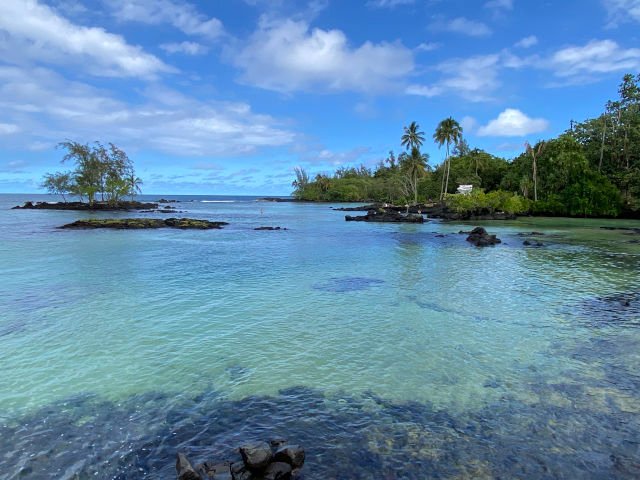
Carlsmith Beach Park
Carlsmith Beach Park is another one of the beaches in Hilo that is fairly close to downtown Hilo. It is an 8-minute drive from downtown Hilo off of Kalanianaole Street and is right next to James Kealoha Beach Park. There is limited parking at this beach. However, you can park on the street or in the James Kealoha Beach Park parking lot. The walk from James Kealoha Beach Park is no more than five minutes to Carlsmith Beach Park. There is a restroom facility near the parking lot, as well as a shower area for rinsing off after swimming.
Similarly to Kealoha Beach Park, there is no sand beach. However, there are a few swimming areas to choose from. Close to the parking lot is a calm bay area with steps into the water from the wall that separates the grass area from the water. The swim area near the parking lot is a great spot for children due to the calmness of the water. The water at Carlsmith Beach Park was very calm due to the lava rock formations surrounding the swimming areas. Overall, Carlsmith Beach is probably one of the best beaches on the big island for swimming due to the calm, clear blue water.
Carlsmith Beach Park is a great place to swim and snorkel. You might even see a Hawaiian green sea turtle, as it is common to see one here. If you do see a green sea turtle, give the turtle space and do not touch them. The turtles are a protected species in the United States.
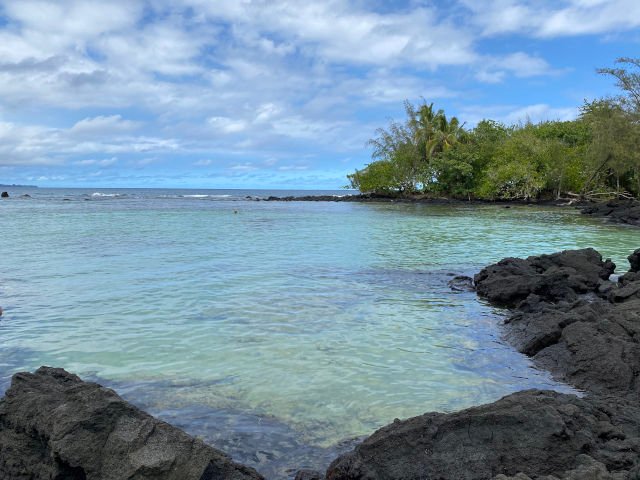
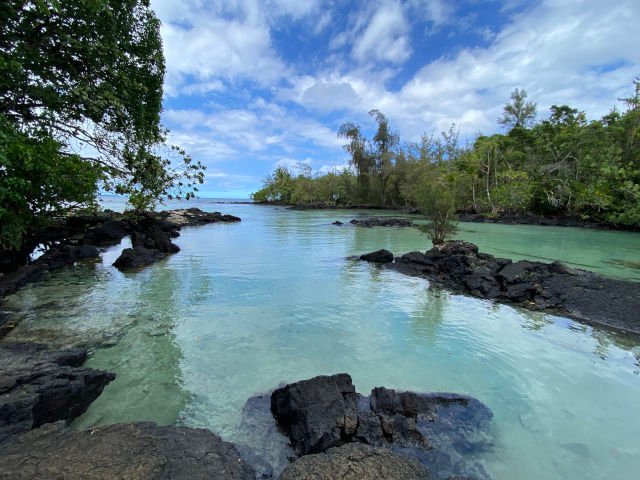
Wai’olena Beach Park
Wai’olena Beach Park is about a 9-minute drive from Downtown Hilo. It is also located off Kalanianaole Street and is very close to Carlsmith Beach Park. There is a small parking lot with street parking also available when the parking lot fills up. Wai’olena Beach Park also has bathroom facilities and showers to rinse off after swimming in the ocean.
Wai’olena Beach Park has a few picnic tables available for use in a grass area that is perfect for a daytime picnic. There is a large pond area for swimming near the picnic area. Wai’olena has a rocky coastline with steps built into the lava rock, making entry into the ocean easier. Care should be taken when entering the water. Due to the rocky coastline, it would be a good idea to use water shoes. You will find strong currents and ocean breaks along Wai’olena Beach Park. However, because of the rocky coastline, Wai’olena can be a great place to look for sea life in its lava tide pools.
Richardson Ocean Park
Richardson Ocean Park is about a 12-minute drive from Downtown Hilo off Kalanianaole Street in Hilo. A parking lot is available for use; however, if the lot happens to fill up, you can also park on the street. Richardson Ocean Park also has bathroom facilities and a shower for rinsing off after your ocean swim. There is a grass area where you can have a picnic, relax, or lay out in the sun. While we were at Richardson Ocean Park, there was also a lifeguard on duty.
Richardson Ocean Park is Hilo’s only black sand beach, making this a must-see ocean park. Many of the beaches in Hilo do not have much of a beach. Instead, the beaches have lava rock step formations that are used to enter the water. Having a black sand beach in Hilo to enjoy was fantastic.
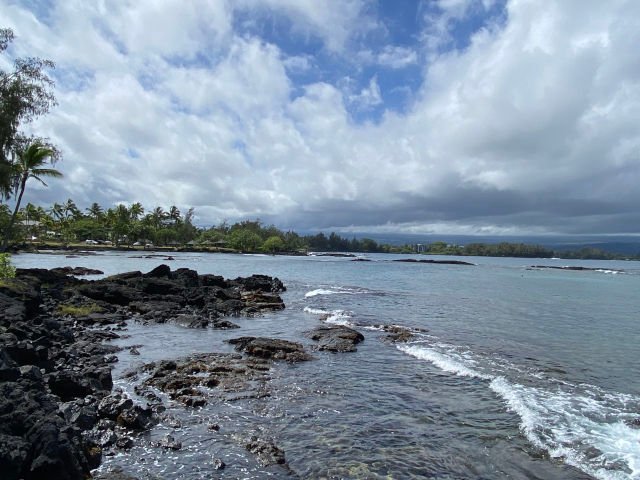
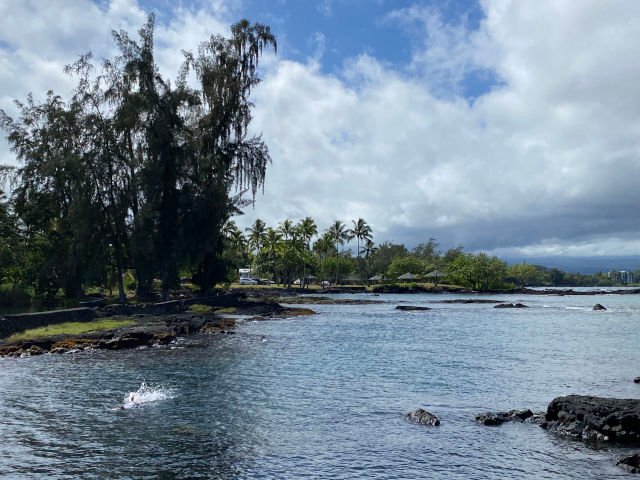
Waiuli Beach Park / Leleiwi Beach Park
Waiuli Beach Park, also known as Leleiwi Beach Park, is about a 13-minute drive from downtown Hilo. This is a popular beach not too far from Richardson Beach Park and Wai’olena Beach Park. There is ample parking available with street parking available as well. The beach park also has bathroom facilities and showers for rinsing off after swimming. Waiuli Beach Park has a large grass area with several covered picnic areas. There are BBQ pits available as well.
Waiuli Beach Park has ponds and protected swimming pools, making this a great beach for swimming and snorkeling. The coastline is rocky, with steps formed from lava rock that help enter the swimming ponds. Having a pair of water shoes to protect your feet as you enter the swimming pools is a good idea. The tide pools near the shoreline make this a great place to snorkel and explore the sea life in the pools.
Onekahakaha Beach Park
Onekahakaha Beach Park is about a 9-minute drive from Downtown Hilo at the end of Onekahakaha Road off Kalanianaole Street. There is ample parking at Onekahakaha Beach Park for visitors. There is a bathroom facility with showers, changing stalls, and an outdoor shower area to rinse off after swimming.
The pools at Onekahakaha Beach Park are protected by natural lava and man-made lava rock walls. The pools at this beach park are perfect for children as they are shallow bays with relatively calm water. The water in the pools range from about two to about four feet deep. The shallow pools make this the perfect beach for little ones. There are also tide pools that can be explored. If you do decide to explore the tide pools, wearing water shoes will protect your feet as you walk along the lava rock.
In some areas of the beach park, the lava rocks are flat. While not as comfortable as a sandy beach, the flat lava rock is perfect for sunbathing. Be cautious if you decide to swim in the areas outside of the protected pools. You are likely to encounter strong currents.
Facilities Available at Onekahakaha Beach Park
Onekahakaha Beach Park is a large park with many cool features. One feature at this park that stood out was the Uncle David K. Calles Horseshoe Court. There are about eleven courts available to play horseshoes. The horseshoe court is open daily from 9:00 a.m. to 6:00 p.m. There is a large grass area with trees, a covered picnic table area, and a swing set for kids. The facilities available at Onekahakaha Beach Park make this one of the best beaches in Hilo. It is possibly one of the best beaches on the Big Island for families with young children.
Why a trip to Hilo should not be missed
Hilo is a beautiful town with warm and friendly people. There are many natural attractions to visit. You will find waterfalls, scenic hikes, a botanical garden, and beautiful beaches to visit in or around Hilo. Hilo is also close to one of the most unique National Parks in the United States, Hawaii Volcanoes National Park. As the largest town on the Big Island, Hilo has a distinct charm that sets it apart as a must-visit destination. Hilo’s genuine warmth and laid-back atmosphere make it an ideal place to slow down, connect with locals, and appreciate the beauty of the Big Island. If your travels include other areas of Hawaii Island, you can read about other amazing things to do on the Big Island.
Popular & Related Posts
- Visiting the Polynesian Cultural Center in Oahu, The Ultimate Guide
- 24 Amazing Beaches on Oahu to Experience & Visit
- 24 Amazing Things to Do on the Big Island of Hawaii
- 18 Amazing Beaches on the Big Island of Hawaii
- 8 Best Things to Do at Volcanoes National Park
- 75 Top Things to Do in Oahu – The Ultimate Guide for Your Oahu Vacation
- 24 Family Friendly Things to Do in Oahu with Kids
- Visiting the Byodo-In Temple in Oahu – A Complete Guide
- Kualoa Ranch – Hawaii’s Jurassic Park Aventure Tour
- A Guide to Visiting the Dole Plantation in Oahu

